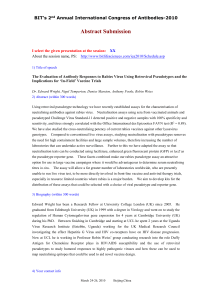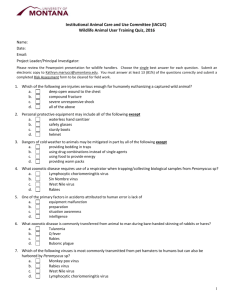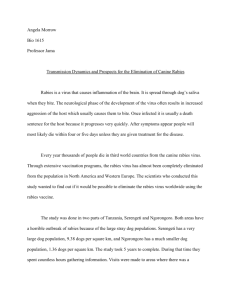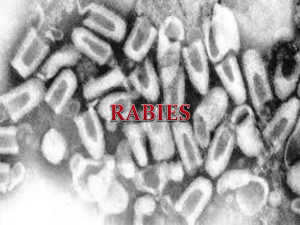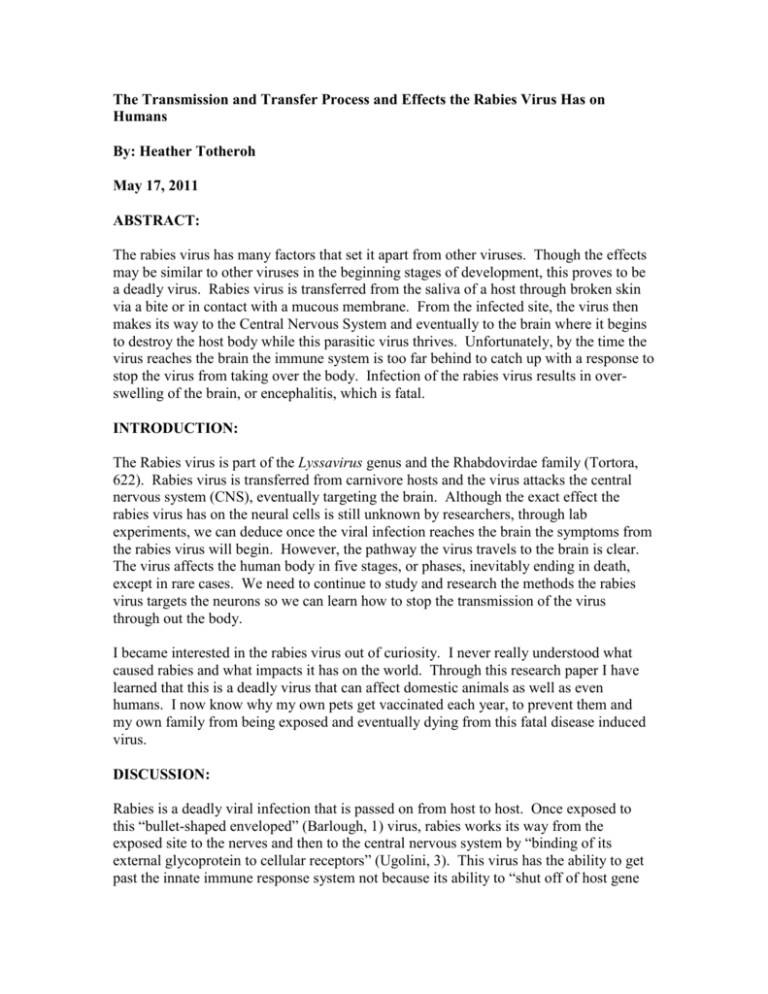
The Transmission and Transfer Process and Effects the Rabies Virus Has on
Humans
By: Heather Totheroh
May 17, 2011
ABSTRACT:
The rabies virus has many factors that set it apart from other viruses. Though the effects
may be similar to other viruses in the beginning stages of development, this proves to be
a deadly virus. Rabies virus is transferred from the saliva of a host through broken skin
via a bite or in contact with a mucous membrane. From the infected site, the virus then
makes its way to the Central Nervous System and eventually to the brain where it begins
to destroy the host body while this parasitic virus thrives. Unfortunately, by the time the
virus reaches the brain the immune system is too far behind to catch up with a response to
stop the virus from taking over the body. Infection of the rabies virus results in overswelling of the brain, or encephalitis, which is fatal.
INTRODUCTION:
The Rabies virus is part of the Lyssavirus genus and the Rhabdovirdae family (Tortora,
622). Rabies virus is transferred from carnivore hosts and the virus attacks the central
nervous system (CNS), eventually targeting the brain. Although the exact effect the
rabies virus has on the neural cells is still unknown by researchers, through lab
experiments, we can deduce once the viral infection reaches the brain the symptoms from
the rabies virus will begin. However, the pathway the virus travels to the brain is clear.
The virus affects the human body in five stages, or phases, inevitably ending in death,
except in rare cases. We need to continue to study and research the methods the rabies
virus targets the neurons so we can learn how to stop the transmission of the virus
through out the body.
I became interested in the rabies virus out of curiosity. I never really understood what
caused rabies and what impacts it has on the world. Through this research paper I have
learned that this is a deadly virus that can affect domestic animals as well as even
humans. I now know why my own pets get vaccinated each year, to prevent them and
my own family from being exposed and eventually dying from this fatal disease induced
virus.
DISCUSSION:
Rabies is a deadly viral infection that is passed on from host to host. Once exposed to
this “bullet-shaped enveloped” (Barlough, 1) virus, rabies works its way from the
exposed site to the nerves and then to the central nervous system by “binding of its
external glycoprotein to cellular receptors” (Ugolini, 3). This virus has the ability to get
past the innate immune response system not because its ability to “shut off of host gene
expression,” but because of its P proteins on the outer shell that inhibits the production of
the innate response gene
(Finke, 5). The “mutant
strains develop rapidly”
making it hard for immune
responses to catch up with
the virus (Tortora, 622).
From there the virus can
travel up the nerves to the
spinal cord and into the
brain. Rabies then begins
to infect various tissues of
the brain and other organs.
In most of all cases
reported, death is
inevitable.
http://spot.pcc.edu/~jvolpe/b/bi234/lec/11_viruses/images/fig13.5d_RabiesVirus.jpg
The transmission of this fatal virus has various options from host to host. In “Rabies in
Animals and Man” research has proved that the most common transmission method of
the rabies virus “to man and domestic animals is undoubtedly by the bite of a rabid
animal” (West, 90). Because the virus is contained in the saliva of a rabid animal, the
puncture from the bite gives the virus direct access to the body of a new host. The saliva
of a rabid animal is the vector that we need to watch out for. One way that humans can
be infected with the rabies virus is not only by a bite to the skin, but a lick on any part of
the body where the virus can come in contact with a “mucous membrane” (West, 91).
The rabies virus is able to “penetrate intact mucous membrane” which includes areas of
the “mouth, lips, nose, eyelids as well as the digestive tract” (West, 91). There have been
reported cases of humans getting infected by the virus simply because a rabid dog licked
a man’s face. Also, eating contaminated “meat from a carcasses’ of rabid animals” has
also shown to infect the next hosts (West, 92). There have even been some reported
cases where people have been infected with rabies by exploring bat infested caves. The
rabid bats transmitted the virus through “aerosol transmission” from their saliva, breath,
or urine that was then inhaled by the explorers, where the virus then developed in their
“lungs and trachea” (West, 94). In some cases, Rabies can be a latent response and be
passive until a trigger such as stress activates the virus (West, 95). This type of infection
normally only occurs when the amount of transmitted virus was in low concentration
(West, 95). In 1971, there was no evidence that the rabies virus transmission could occur
from insects to mammals or birds according to West (97). By being aware of the ways of
transmission of the rabies virus we can protect ourselves early before the virus carries on
its pathway to killing us.
As previously state, the rabies virus targets the CNS and the Brain. This disease, rabies,
“almost always results in fatal encephalitis” or swelling of the brain (Tortora, 622). So
how is it that this virus can cause those infected to die from encephalitis from just a
single bite? The pathway by which the rabies virus travels is vaguely understood, but the
basics can be examined in Tortora’s book “Microbiology. An Introduction”. Here, he
displays that the first step of the pathology of a rabies infection is that “the virus enters
the tissue from saliva of a biting animal” (Tortora, 623). Through fluorescent
microscopy researchers discovered the virus gathers in “in regions of high density
acetylcholine receptors” (Burrage, 1). The frequency of human’s being infected with the
rabies virus normally happens from dogs. Unlike other opportunistic pathogens, rabies
then “multiplies in skeletal muscle and connective tissue” and because this virus is
transmitted in such low doses, there are not enough signals to trigger the immune system
to attack the intruder (Tortora, 623). Also, while most virus and bacteria enter into the
bloodstream or the lymphatic system, the immune system can access these pathogens
easier. But, because the rabies virus is harvested in the muscle tissue, the immune system
cannot recognize it as easily. Once the virus has multiplied, it moves through the tissues
at about “15 to 100 mm per day”, “up [the] peripheral nervous system to CNS” (Tortora,
623). When the rabies virus reaches the nerves the immune system can not access the
virus until it begins to damage the
CNS by which time an immune
response is “belated and ineffective”
(Tortora, 623). Rapidly the virus
shoots up the spinal cord until it
reaches the brain. Once in the brain,
the infection of the virus triggers the
onset of symptoms, one of them
being encephalitis. The viruses last
location in this host is located in the
victims “salivary glands and other
organs” (Tortora, 623). The next step
in the transfer process is from host to
host and the cycle re-circulates. The
pathway the rabies virus takes effects the host in multiple ways.
http://alternativehealthcarenews.blogspot.com/2010/01/fitness-tips-facts-rabies-virus.html
The effects the rabies virus has on the body causes various symptoms once it enters the
brain. A host that is infected can expect these symptoms and can be categorized in five
separate stages. Each stage contains particular symptoms. The first stage is the
incubation phase (Tortora, 623). This is after the host has been exposed to the rabies
virus. There are no symptoms in this stage because the virus not in the brain yet. The
length of the incubation period varies depending on the location of the exposed site
(Barlough, 1). The closer the site of the bite is to the CNS the shorter the incubation
stage. The next stage of effects is the “prodome” or prodomal meaning beginning
symptoms of a disease (Department of Health Services [DHS], 3). In this clinical phase
of the rabies virus symptoms consist of “nonspecific” symptoms like fever, fatigue,
headaches, nausea, and sore throat (DHS, 3). The next phase that follows the prodomal
stage is “acute neurologic period” (DHS, 3) that can result in “alternation between
periods of agitation and intervals of calm” (Tortora, 3). While the rabies virus is
attacking the CNS system in this acute phase, hosts can feel anxious and hallucinate
while also having trouble swallowing. This is when the “spasms of the muscles in the
mouth and pharynx” begins and are onset by stress of swallowing water. “The mere sight
of water can set off the spasms” a severe case of hydrophobia. The rabies virus has now
reached the salivary glands, causing them to over-salivate so they can jump to the next
host easier, hence the phrase associated with rabies: “foaming at the mouth”. The fourth
stage of effects the rabies virus has on the host body is a coma. The coma can last for
“hours to months” (DHS, 3). This eventually results in the fifth stage of death caused by
encephalitis. Except for the one rare case that Carly McCready will discuss, rabies is 100
percent fatal once symptoms begin.
The fatal disease caused by the rabies virus still has a lot of wholes and gaps in
understanding that researchers need to continue to try and solve. By learning more about
the transmission and transfer process of this disease we can recognize rabies in the early
stages of development so hopefully we can stop the virus before it kills more hosts.
LITERATURE CITED:
Barlough, Jeffrey E., Fred W. Scott, and James R. Richards. "Rabies." Welcome To Max's
House Animal Rescue - Feline Health, Behavior & Nutrition. Web. 16 May 2011.
<http://maxshouse.com/rabies.htm>.
Burrage, TG, GH Tignor, and AL Smith. "Rabies Virus Binding at Neuromuscular
Junctions." NCBI. PubMed, 1985. Web. 15 May 2011.
<http://www.ncbi.nlm.nih.gov/pubmed/3890406>.
Finke, Stefan, and Karl-Klaus Conzelmann. "Replication Strategies of Rabies Virus."
Virus Research 111.2 (2005): 120-31. Science Direct. Web. 15 May 2011.
<http://www.sciencedirect.com/science?_ob=ArticleURL&_udi=B6T324G4MM9P2&_user=521830&_coverDate=08%2F31%2F2005&_rdoc=1&_fmt=high&_orig
=gateway&_origin=gateway&_sort=d&_docanchor=&view=c&_acct=C0000595
81&_version=1&_urlVersion=0&_userid=521830&md5=292a7ea70123a61c92a5
0b3f3783d41c&searchtype=a#SECX6>.
"Occupational Exposure to Rabies Virus." Occupational Exposure to Rabies Virus.
Department of Health Services, Sept. 1998. Web. 15 May 2011.
<http://www.cdph.ca.gov/programs/hesis/Documents/rabies.pdf>.
Tortorta, Gerard J., Berdell R. Funke, and Christine L. Case. Microbiology An
Introduction. 10th ed. San Francisco: Pearson Prentice Hall, 2010. Print.
Ugolini, Gabriella. "Specificity of Rabies Virus as a Transneuronal Tracer of Motor
Networks: Transfer from Hypoglossal Motoneurons to Connected Second-order
and Higher Order Central Nervous System Cell Groups - Ugolini - 2004 - The
Journal of Comparative Neurology." Specificity of Rabies Virus as a
Transneuronal Tracer of Motor Networks 356.3 (2004): 457-80. Sonoma State
University. Web. 15 May 2011.
<http://onlinelibrary.wiley.com/doi/10.1002/cne.903560312/pdf>.
West, Geoffrey P. . Rabies in Animals and Man. Newton Abbot: David Et Charles, 1972.
Print.


